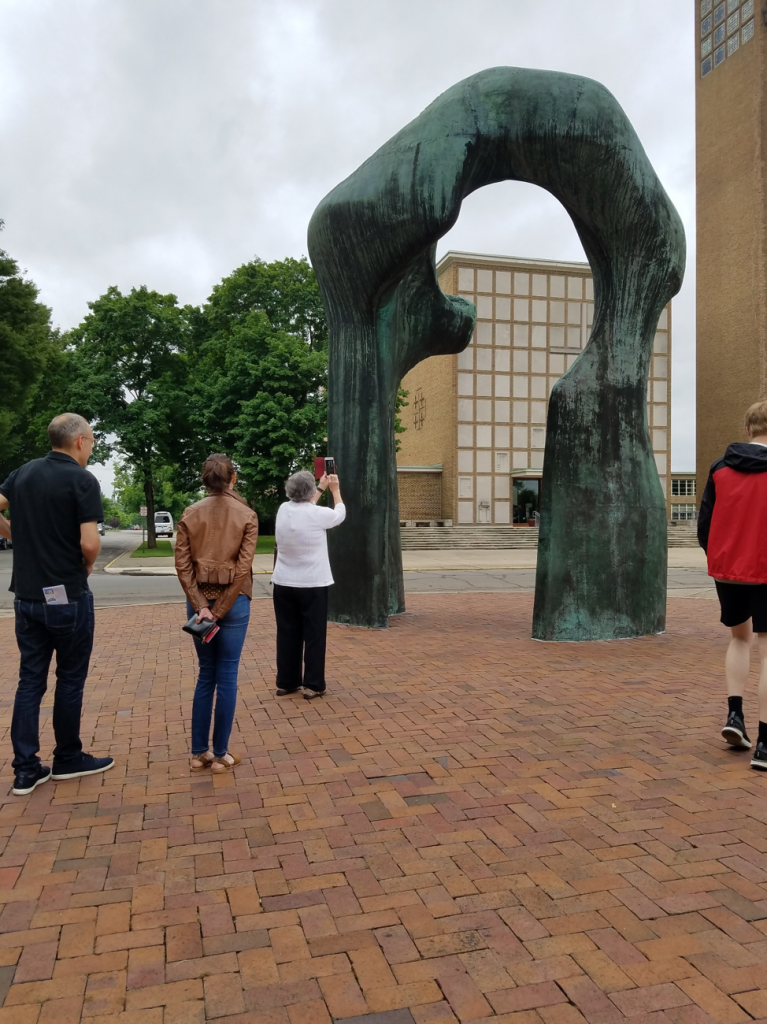
by Travis Cooper
On one humid, overcast summer day, an unpredictable ethnographic experience got me thinking about urban myth-making, sanctioned versus unsanctioned narratives, and contested public space.
The incident occurred as follows.
Among a group of architectural tourists on Columbus’s Avenue of the Architects, I observed as our tour guide — who I’ll call Eric — detailed I.M. Pei’s design methods for the plaza. Eric was a walking encyclopedia of architectural data, dropping design concepts such as subtractive architecture and coffering. He pointed out how the various architects who contributed to the environs aimed for a loose structural consonance. “Look how that walkway lines up, visually, with the clock tower,” he encouraged. He signaled toward the parallels between the texture of the underside of the library’s flat roof and the honeycomb pattern on nearby plaza benches.
We walked slowly toward the plaza’s center, trailing behind Eric as he approached the sculpture backwards, gesturing this way and that, deeply engaged in tour guide rhetoric. As we neared the foot of avant-garde sculptor Henry Moore’s Large Arch at the center of the plaza, an unexpected interruption resulted in a moment of awkward pause. A middle-aged man to our left, slightly unkempt and with cigarette in hand, interjected into Eric’s official soliloquy. “It’s Godzilla’s leg-bone, man!” he exclaimed, stepping forward from where he had been leaning against the red-brown brick of Pei’s library façade. Face bright with the attention he drew, from a distance this temporarily emboldened, unsanctioned guide traced the contours of the bronzed form with an outstretched finger.
Indeed, we all saw it: from the right angle, Moore’s arch did look anatomical and reptilian. This massive sculptural object in front of us, if one beheld it correctly, certainly resembled what could be the pelvic bone of Godzilla, or Gojira, one of the most urban-oriented monsters in pop culture history. I recall being struck, in that moment, by the accuracy of the folk commentary and counter-narrative applied to this esteemed cultural artifact.
Ever the professional, Eric was not in the least taken aback. He had broken off his narration when the interruption occurred but immediately regained control of the discourse by signaling our group closer to Moore’s creation (read: politely and effectively ignoring the source of the disruption). Eric beckoned us still closer in proximity, knocking on the sculpture to contrast its bronzed exterior and hollow core. He then launched into the full cultural history of the object’s trans-continental travels. As a group we tuned back into the authorized, city-approved narrative of the avenue, plaza, and Large Arch, narrating the sculpture’s multi-site assembly in Germany, crossing the Atlantic, traveling up the Missouri and Ohio Rivers, and completing the final leg of its tumultuous journey by semitruck.
Crisis averted.
I’ve spent much of this summer studying the architourist networks that fuel the economy of Columbus, Indiana, a modern urban experiment known as “Athens of the Prairie.” The city is home to one of the earliest examples of modern church architecture in the nation, First Christian, a collaborative project headed by Eliel Saarinen but indebted to the design skills of his own son and a young Cranbrook associate, the Eero Saarinen and Charles Eames duo, who worked on interiors and furnishings.
Playing the role of the chameleonic ethnographer, in the field I’m both tourist and anthropologist, design nerd and social theorist. I’ve tracked hours and hours observing people observing buildings and noted interactions between tourists, locals, and the tour guides who serve as the city’s architectural specialists, applied historians, and appointed myth-makers.
As this vignette suggests, urban spaces are conflicted spaces. Public areas and the cultural objects contained within them are sites for contesting and defending boundaries, politics, and values. Urban spaces, like the cities they constitute, are replete with interpretive variety rather than homogeneity. In short, people’s complex and contradictory commentaries about urban space, including deliberations about the meaning of public art, are what make them so anthropologically interesting. With the case of the Moore sculpture, I observed in real-time as a witty local counternarrative, ringing with a playful institutional disrespect, cut into and reinterpreted the official, city-authorized account.
What is the Large Arch but an ongoing semiotic event, an emplaced assemblage holding ground at the symbolic center of the city? The sculpture means little on its own, standing there in the plaza in the rain and humidity. It holds no objective, singular meaning. Rather, the artifact exists by way of the vivid discourses and narrations that enshroud and enliven it.
Large Arch, yes, but also Godzilla’s leg-bone.
Travis Cooper holds a dual doctoral degree in anthropology and religious studies from Indiana University—Bloomington. He is a fellow with Lived Religion in the Digital Age, an urban research initiative headquartered through St. Louis University. He lectures at Butler University, in Indianapolis, and is working on a book project entitled Synecdoche, Columbus: An Anthropology of an Urban Design Experiment.
